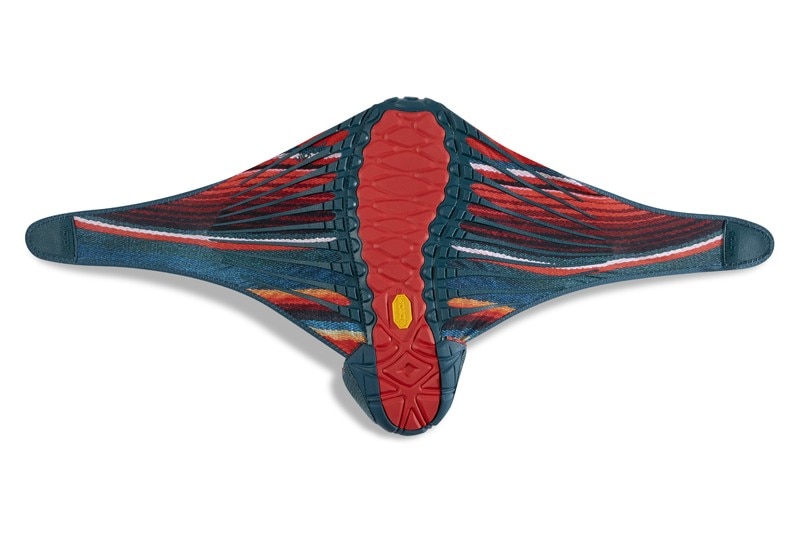Furoshiki are a type of traditional square wrapping cloth that Japanese people use to transport all kinds of objects. They come in different colors and sizes, so that you can carry a dress, a bento box, a bottle or a watermelon – the (ancient) technique for doing it is always the same. On the other hand, Furoshiki are also a pair of shoes launched almost six years ago by Vibram, a long-established Italian company specializing in the production of rubber outsoles for footwear. They are very peculiar and innovative shoes that, instead of the shoe upper, feature two fabric wings that can be wrapped around the feet. Basically, it’s more like a sole with a shoe, rather than a shoe with a sole. Their full name is Vibram Furoshiki The Wrapping Sole, and they were awarded the Compasso d'Oro in 2018, the Grand Award in the Design for Asia Awards in 2017 and the Italian Innovation Award by the President of the Italian Republic. Today, they are in their third generation. How they were born “is a very Italian story” and at the same time a project with a “funny development”. This is what Vibram concept manager Masaya Hashimoto tells Domus with his distinctive style – a very fluent Italian characterized by sudden and inspiring Haiku-like constructions that clearly reveal his Japanese origins as well as the fact that he’s has been living in Italy for a long time. “From the very beginning to the final product, everything has changed”, the designer recalls. At the basis of Furoshiki there is a requirement that hasn’t been met yet.
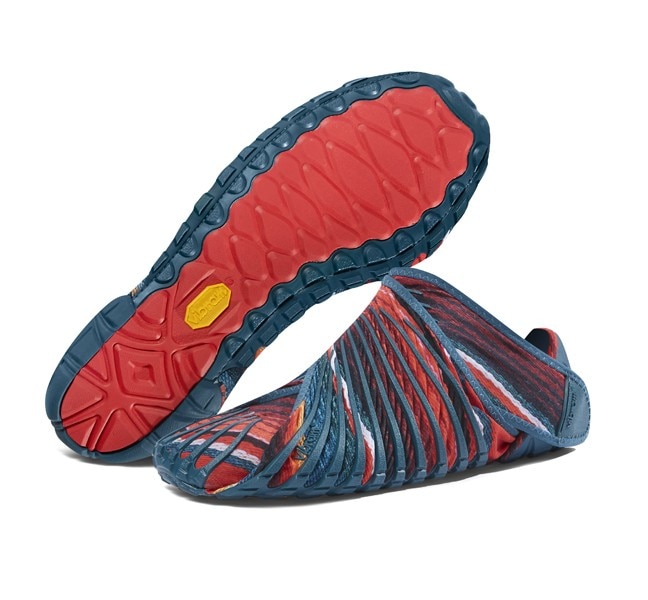
How it all started
“We make shoe soles. Sports, casual, work”. This is how Masaya summarizes Vibram’s mission statement. On its part, the name of the company summarizes in a way that is quite common among northern Italian companies the name of its founder, Vitale Bramani, who was an alpinist and also the inventor of the carrarmato (tank tread) soles. A few years ago, his nephew Marco, who’s now president of the company, challenged his designers to reduce the amount of shoe sole moulds, since each shoe size corresponds to a particular mould, and managing them is a very complicated task. Masaya Hashimoto was one of those designers. “I started thinking and asking myself questions,” he recalls, adding that he focused above all on the fact that the shoe upper – the “shoe box” – had to follow the size of the sole. It was 2011, and that’s when he thought of Furoshiki, “more as a reaction than as an answer”. However, the original question hasn’t been given an answer yet. “I still haven’t satisfied Marco Bramani”, says Masaya.
That night
“I woke up at 4 a.m. with the Furoshiki cloth on my mind". At that point, Masaya was very interested about two aspects of the traditional Japanese wrapping cloth. First, the shape of the Furoshiki changes according to what you put inside of it. “This discovery is very important – normally, it is the user who has to adapt to the shoe, not the other way around”. English or Italian shoes may not be suitable for Asian people, who tend to have shorter and wider feet, he says. “this also happens with the suitcase, which is a container with a fixed shape that doesn’t change according to what needs to be carried”. If the first important aspect is shape, then the second is decoration. The fabric of the furoshiki cloths can change according to the occasion – for a wedding it is white, but maybe if you have to carry a watermelon, you’ll use a green one. “Like this, the shoe could become something different. In our case, a wrapping sole”.
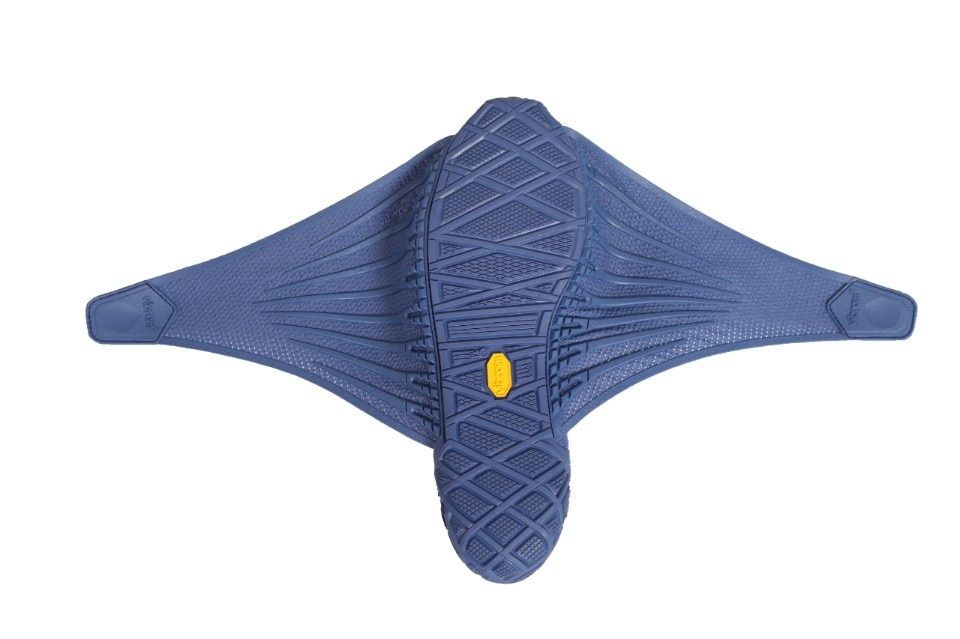
Today, there is no master, no design thinking, no strong personalities who propose something, whether it sells or not. Now everything is homogeneous, marketing and sales are in charge. I kind of miss the ‘80s
The prototype.
“My wife must have thought I was crazy, seeing me getting up like that at 4 in the morning”, laughs Masaya, who at the time – he adds – had recently gotten married. That night, however, he created the first draft of the product – a sole in the middle of a cloth, which could be adapted according to the size of the foot. “The very next day I went to the hardware store and bought some liquid rubber. Then I went to the lab and tried to make a prototype starting from a scrap of fabric that I had found there. I liked the colour. Usuallyfuroshiki are square shaped, so at first I used the same shape”.
The next step was to present the prototype to the supervisor. A special supervisor – Marco Bramani was president of the company, but also artistic director. “Today it’s quite rare, but in Italy it was quite common,” says Masaya, who has been working as a designer in Italy since he was twenty years old. Bramani saw the prototype and liked it. “He said: beautiful. He too had forgotten what he had asked me”.
At Vibram, this isn’t bizarre at all – many ideas start out in one way and transform along the way, especially when they are presented to loyal customers who frequent the brand’s official shops (in Milan, Montebelluna and Boston), and to potential customers who have never heard of Vibram before.
So, in March 2011, the Furoshiki were designed and the first prototype was created. Then, in collaboration with the Vibram testing team, as Masaya recalls, “we started to define what kind of shoe it was, what kind of sole to use, what kind of blend to use, how to make it and produce it”. The prototypes finally came from the Chinese office. “Also thanks to the different time zone, we made a drawing and received the prototype the next day”.
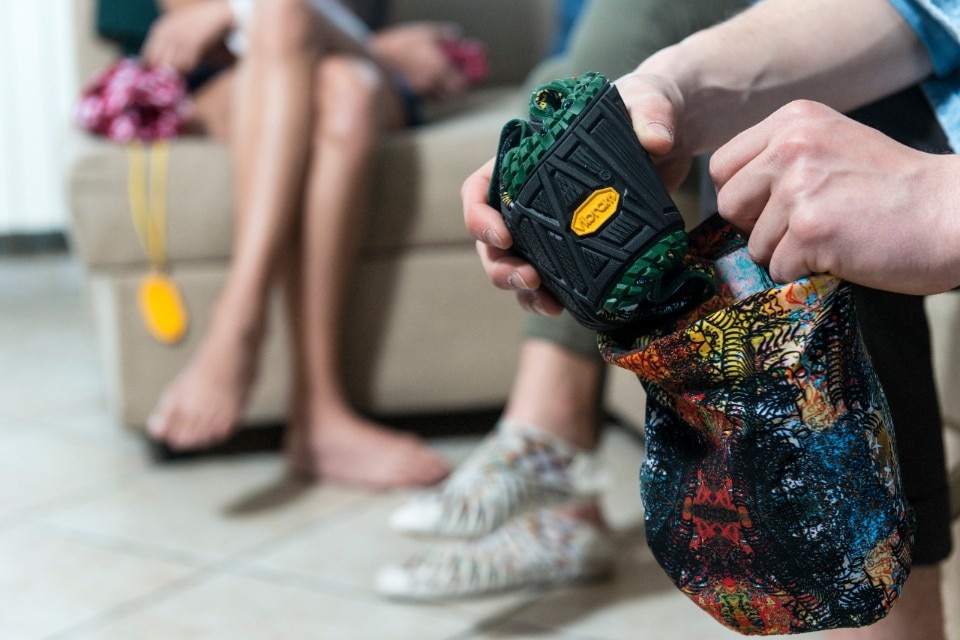
Masaya, Vibram, soles and innovation
“Vibram is a company in the tertiary sector: what we offer is a part of the shoe, the most important part of the shoe – the sole. And we feel that the sole should be even more innovative. Our way of thinking is innovative, our shoes should be stimulating for the industry. They shouldn’t represent competition for our clients, but at the same time they should be stimulating for the company, in order to innovate from within. All through advanced design”. That is, through the shoe models that Vibram produces on its own, namely Five Fingers and Furoshiki. And any others that may come in the future.
In the East, we suffer because of the European shoe culture – we want to follow it but it is not right for our feet
The arrival of Furoshiki represented for Vibram the introduction of something different, something new. “In the East, we suffer because of the European shoe culture – we want to follow it but it is not right for our feet. So, we have studied feet, and how they change during the day,” says Masaya, who during our conversation shows me several images of all the research done during Furoshiki’s development. A project that has certainly changed something in the Lombardy-based company. “It will take some time to see it, because the company’s tradition is still European, but at the same time China, for example, which used to be where production takes place, is now potentially the main market. From there, something could be soon created, especially in a saturated market where we are discussing how and what a niche production will be”. Here, Furoshiki has stimulated the conversation.
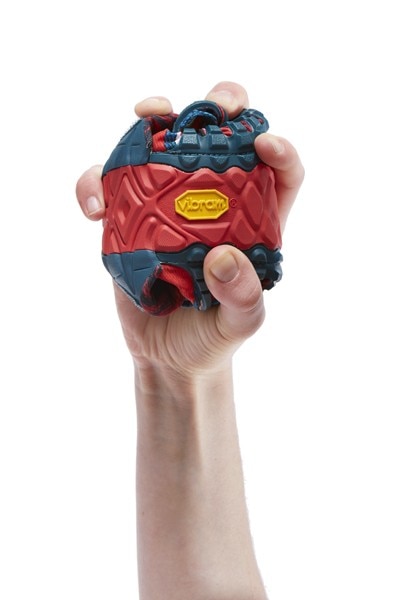
The beautiful, the bad and the marketing
“I started working in Italy in the ‘80s,” recalls Masaya Hashimoto. “I met all the great masters – Memphis, Alchimia. Alberto Rosselli taught me that one of the aims of design is to create difference. Being different can be seen in opposition, but it creates hybrid, interesting objects.
Italy and Japan are in tune for a lot of things. Even when it comes to design, the approach is different – for a Japanese person, the chaotic Italian method is interesting. That’s why I'm here, and not in America or England or Germany. I don't like order. Here in Italy every time we meet, we discuss change. When someone comes up with a brilliant idea, we say ‘beautiful’. And I always wait for this word, ‘beautiful’, which isn’t only used for pleasing aesthetics, but also for smart solutions.
I studied in Japan, and at the age of 22 I started working here. Today, there is no master, no design thinking, no strong personalities who propose something, whether it sells or not. Now everything is homogeneous, marketing and sales are in charge. I kind of miss the ‘80s”.
The launch
Furoshiki started being sold in 2015, but they made their debut the previous year, at Pitti Uomo. The shoes participated in the most important fashion fair for men’s clothing after an incubation of almost 4 years, during which the company worked a lot on the shoes, as Masaya recalls. “To whom to sell them, how to sell them”, first of all. But that’s not all. Some solutions took a long time to be found. When it comes to the fabric used, the collaboration with EuroJersey was crucial – they proved to be the perfect partner with which Vibram managed to obtain an unusual continuity of the sole with the upper. “Attaching the fabric to the sole was not easy, we had to run a lot of tests”. In the end, a completely new method that uses polyurethane was invented.
Vibram is a company in the tertiary sector: what we offer is a part of the shoe, the most important part of the shoe – the sole. And we feel that the sole should be even more innovative
Furoshiki’s great design challenge is to design a two-dimensional product that turns into a three-dimensional one that wraps around the feet and adapts to their shape, which will always be different. “In the very first model, the aesthetics were not so good, it looked a bit like a spring roll,” says Mayasa. “It took quite a lot to see some kind of improvement, two or three generations of models”. But when the shoes were first sold five years ago, the “shoe maniacs”, as the designer calls them, immediately bought them. “Even on the evening of the presentation at Pitti, we went to a disco and there was a guy dressed in black and wearing some strange shoes”. They were obviously Furoshiki, he remembers. I asked him if he had tried to ask him what he thought of them. “Sure, I approached him and he told me he had just bought them in the shop in Milan. He found them interesting and beautiful, and he wanted to give them a try”.
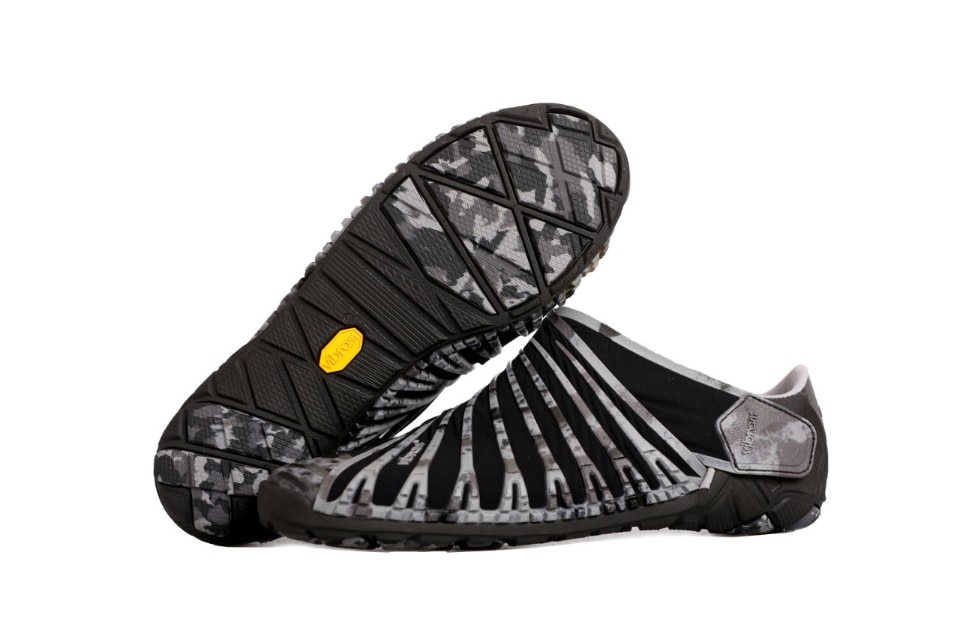
Furoshiki, today
The other shoes tha Vibram produces, called Five Fingers, are explicitly sporty. Furoshiki, on the other hand, are the versatile shoes that are perfect for any occasion. Casual in the deepest sense of the word. “I use them when I travel, I use them at the airport. I use them to do yoga,” says Masaya. “Those who wear them, create a new way to use them. They are almost ten years old, but we are still getting feedback on how to improve them. They are shoes that live in symbiosis with the bag with which they are sold, a bag made with the same mould, so as not to waste fabric, and which allows you to always carry a second comfortable shoe with you, “maybe I’ll get invited to an aperitivo after work and I’ll want to wear different shoes”.
The one currently on the market is the third generation of Furoshiki. The first is “the spring roll”. In the second one, toe box and wings were modified. The last in order of time is Furoshiki Evo, a name that recalls the sole made of ethylene vinyl acetate (eva), which is taller than the previous models.
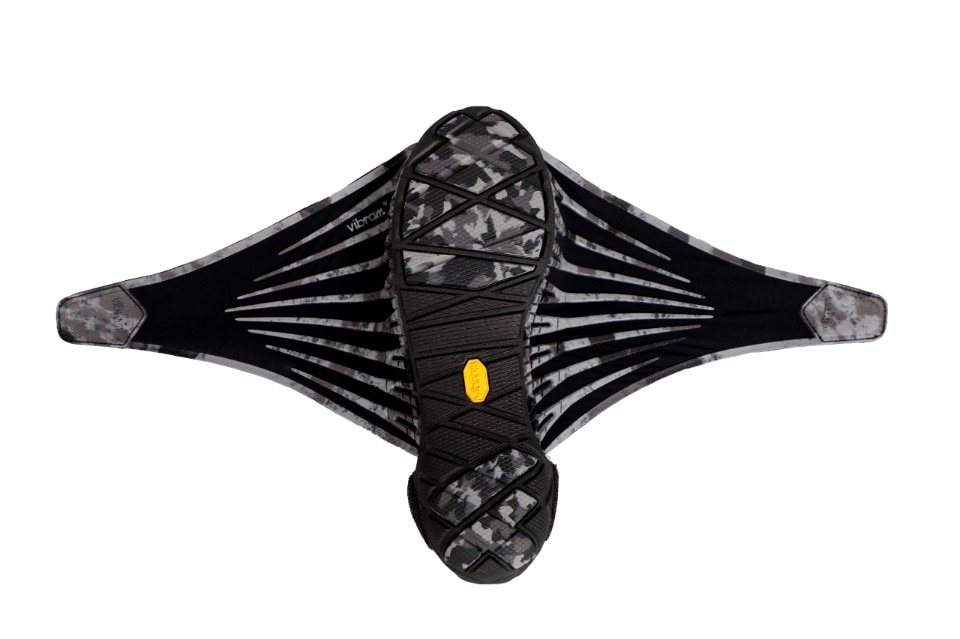
Design trattoria
The Furoshiki Evo soles were created to attract a different type of customer. They’re designed for those who cannot live without a tall sole, especially in the city. Adapting the design of a product to the needs of the user reflects Vibram’s and Masaya’s philosophy, according to which the designer’s task is also to understand for whom he’s...cooking. “It runs in my blood, I come from a family of restaurant owners, I come from Japanese family restaurants, what Italians call trattoria”, he explains. “If a customer, maybe a guest, comes to me and he’s looking tired, maybe because last night he partied and drunk too much, then I’ll hand him today’s menu, but I’ll customize it, or maybe I’ll tell him to just drink green tea and not eat. Instead, today I see many places where there is no contact between the kitchen and the person eating, the food is being prepared regardless of who will eat it. I think that designers must understand for whom they’re cooking, what the client is saying. Defining the product is important, and it’s a process that needs to be optimized”. Then, he goes back to the meaning that design has today. “The market is saturated, there must be some kind of change. And it can’t simply be a comeback to craftsmanship. Industries survive by focusing on niche markets. Now they have to create, and to innovate. Those who start doing this will survive. The first company that presents something new will have the market in the palm of their hands”.


